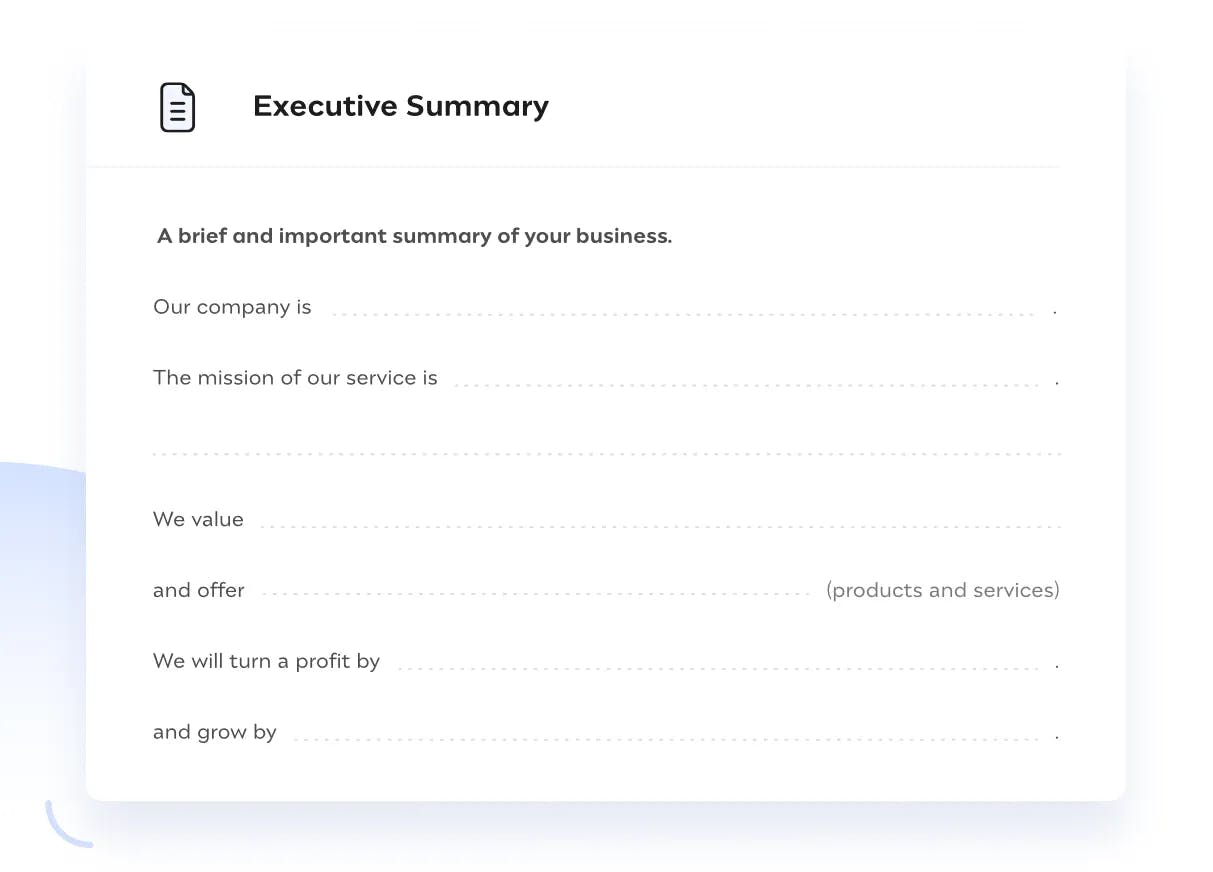Services
Services
Services
Services

Please note: This post contains affiliate links and we may receive a commission if you make a purchase using these links.
A detailed business plan serves as your personal roadmap, providing a comprehensive overview of your business, its goals, marketing strategies, financial projections, and more. And as your business grows, your plan can help you make smarter decisions and find success faster. Writing a business plan may seem intimidating, but breaking it down into manageable steps can simplify the process. And with the help of our free business plan template, all you have to do is fill in the blanks.
Learn how to write a traditional business plan step-by-step:
The executive summary is the first section of your business plan, but we recommend writing it last. That's because it's used to cover the most important points of the rest of your business plan, including your goals, competitors, business model, and the like.
So, for now, simply block out the space where you want your executive summary to go, then come back and flesh everything out once you've written the rest of your plan.
Setting clear and measurable goals is essential for any business. Goals provide a sense of direction and help you stay focused on what you want to achieve.
When outlining your business plan, consider using SMART goals:
Make sure to add an in-depth description of your business to your business plan. Include information about your company's mission statement, vision, and values, as well as your products or services, target market, and the things that set your business apart.
In addition, be sure to include all details about your business's location. For instance, if you plan on renting retail space in your city's downtown neighborhood, mention exactly which part of the neighborhood and why. Or, if you're planning to run your business entirely from home, make sure to note whether or not you'll have a dedicated workspace, where you'll keep your inventory stored, and other key details.
Market research is essential for understanding your niche, customers, and competitors. It should include the following:
Use this information to identify market gaps your business can leverage, learn more about your target customers, and give your business a sharper competitive edge.
In this section, you'll create an overview of your business's legal structure, ownership, and organizational structure.
First, specify your business' entity type. Your options include the following:
(Hint: If you're unsure which entity type is right for you, take our Business Entity Quiz to find out.)
Next, describe your business's ownership structure and all key personnel. For example, mention whether you'll be running your business alone or with a partner, and include any people you intend to hire or work with immediately.
Finally, highlight any business partnerships or alliances you want to pursue.
Here, explain your business model, which is how your business will drive revenue and make a profit. Mention the following:
A well-rounded marketing strategy outlines how you plan to promote your products or services to your target market. You must provide a comprehensive plan that includes your branding, advertising, and promotional strategies.
For instance, you can describe the brand image you plan to create, the advertising and marketing platforms you plan to use (such as search engines, social media, or local publications), or the promotions you plan to attract customers with.
Don't forget to provide an estimate of your marketing and advertising budget along with a timeline for executing your marketing strategy.
Based on your business model and the market research you conducted earlier, estimate your revenue, expenses, and profits for the next one to five years.
Include important information about your startup costs , deductible business expenses , and any business loans you plan on applying for and how you intend to repay them.
For your final step, compile any additional information or notes that support your business plan.
This could include market research data, product or service brochures, legal documents, prototype photos, industry reports, or financial calculations.
To make sure you can easily find the information you're looking for when referring back to your business plan, take the time to organize and label the appendices.
Not all business plans are alike, and there are just as many types of business plans as there are businesses.
So while the steps described above will help you write a traditional business plan, you have other options, too:
With abundant details and a structured format, a traditional business plan is comprehensive and well-researched. You can use a traditional business plan exclusively for your own purposes, or you can submit it to investors when you seek funding.
A lean business plan is like a pared-down version of a traditional business plan. It typically contains all the same critical information but may include less precise and in-depth research and calculations.
Startups looking to bring an innovative product or service to market can benefit from a startup business plan. Specifically tailored for new businesses with lots of growth potential, this type of business plan often includes the founders' strategy for obtaining funding from venture capitalists.
If your business is already established and you want to grow it even more, a growth business plan could be right for you. A growth plan generally includes strategies for increasing sales, expanding into new markets, offering new products, and optimizing current processes.
An internal business plan is specifically geared toward a business's internal members. For example, a business plan could be created to help a company's executive staff stay focused on their most important goals, or it could help a marketing team improve its efficacy and efficiency.
Your first business plan can become irrelevant to your business's current needs over time. To solve this issue, create annual business plans that address your company's most recent changes and highlight any areas of focus.
Want to know how to write a business plan template? It's just like writing a business plan, but instead of filling in the details as you go, you begin by creating placeholders for each section ahead of time.
For example, your business plan template could include placeholders for your:
These placeholders could be entirely blank, or they could include an indication of what each section contains:

Skip the writing process and opt for a ready-to-go template. Download our business plan worksheet to get started immediately.
We talked to experienced small business owners and examined the most widely-shared tips to find the best advice on writing the best business plan possible:
Leo Ye, co-founder and CEO of the online office software Cubo , believes that "every business plan should begin with an explanation of the problem that the business intends to solve, as opposed to a description of the company and the items it will offer."
Be sure to "explain the issue in straightforward language" and always "quantify and justify the cost in dollars or hours. Specificity is preferable to generalizations, which can only weaken your argument."
In addition to the other sections of a business plan, Joshua Rich, CEO and founder of Bullseye Locations , recommends including a section on risk analysis. In this section, you can "Identify potential risks and challenges that your startup may face, and provide a plan for mitigating [them]."
To create a foolproof business plan, Aima Irfan, editor-in-chief of InsideTechWorld , advises entrepreneurs to "always emphasize budget planning" and "be transparent when including income and expenses." This helps to better keep track of progress.
"Don’t forget to include any investments you have already made or plan to make in the future," she says. "Review your budget [consistently] to cut down on unnecessary expenses."
Depending on the type of business plan you're writing, its end reader could be potential investors, fellow business owners, specific employees, or just yourself.
So, be sure to tailor your business plan to the intended reader, and you'll not only see better results but also save yourself some time and effort in the process.
If you've already performed the necessary research and thought about your business's most crucial elements, you may be able to write your business plan in just a few days. But if you're starting with nothing more than a single product idea, your plan might take months to complete.
But no matter how long it takes to write your plan, make sure you're not spending undue time on it. In other words, if your plan is essentially complete but you keep going back to tweak its wording or organization, it's time to stop planning and start taking action.
When it comes to business plan mistakes, learning what not to do can be just as important as learning what you should do. According to the seasoned business owners we consulted, these are the most common mistakes new entrepreneurs make when writing a business plan:
"Many entrepreneurs get ahead of themselves by including unsupported assumptions," said Alex Miles, UK Managing Director of the small business credit card and spend management platform Capital on Tap . Instead, "critical market size calculations should be based on reliable data sources such as surveys and market analysis."
Similarly, Philadelphia Weekly co-founder Sharon Sanders observed that some entrepreneurs "just rely on Google-generated data and sometimes it is not an accurate representation of the market. Hence, they end up failing."
Tatsiana Kirimava, CEO at Orangesoft , recommends resisting the urge to use "business jargon, fancy words, and cliches," as those can "hide the real value from the [reader]."
"Losing focus on cash while writing a business plan is a common mistake," explains Irfan of InsideTechWorld.
"Most people pay attention to profits while creating a plan, and they emphasize on the concept of sales minus costs and expenses equals to profit." But "we spend cash in business, not profits. Hence, it is critical to focus on cash flows."
We have the answers to your most important questions about writing a business plan.
To ensure all your bases are covered, be sure to include these core sections:
Write a complete business plan by following these nine steps:
A detailed business plan can set your business up for success, but it's just the beginning of your entrepreneurial journey. With our services, you can confidently tackle everything that comes next, from forming your business entity and getting the right licenses to filing taxes and managing your finances.
Get Lifetime Customer Support, Free Registered Agent for a Full Year, a Dashboard with All Docs + Additional Services and Much More
Get Started Today


Carrie Buchholz-Powers is a Colorado-based writer who’s been creating content since 2013. From digital marketing to ecommerce to land conservation, she has experience in a wide range of fields and loves learning about them all. Carrie is fond of history, animals and beauty in equal measure. In her free time, she enjoys knitting, playing video games and exploring Colorado's prairies and mountains with her husband. Read more


Get Bizee Podcast
Join us as we celebrate entrepreneurship and tackle the very real issues of failure, fear and the psychology of success. Each episode is an adventure.